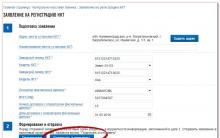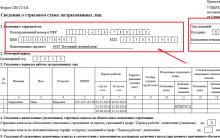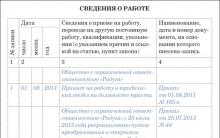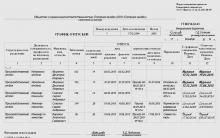The labor legislation of the Russian Federation provides the employer with a number of tools for regulating relations with employees. One of them is the application of a disciplinary sanction - dismissal - for violation of labor discipline, namely absenteeism. However, the application of this sanction against an employee requires compliance with the procedural order and the legality of the grounds.
We all understand that dismissal "under the article" is not the most humane method.
But if an employee systematically violates the rules of internal labor regulations, he skips work. And all possible solutions, such as dismissal or, no longer help.
That leaves only 1 option - the dismissal of the employee for absenteeism. Today we will tell you how to do it correctly and legally.
What is a walk?
Sometimes the employer or employee interprets the concept of "truancy" in their own way. For some, this is a failure to appear at work without warning, for others being late, and someone believes that absenteeism is a refusal to do extracurricular work. To resolve disputes, you need to study what the law says. The legal definition of absenteeism is given in Art. 81 of the Labor Code of the Russian Federation.
Absence from the workplace without good reason during the entire working day (shift), regardless of its (her) duration, as well as absence from the workplace without good reason for more than four hours in a row during the working day (shift) is considered absenteeism.
To qualify for absenteeism, the following conditions must be met:
- absence of 4 or more hours;
- disrespectful reason;
- month of misconduct.
Therefore, before dismissing an employee for absenteeism, it should be established that he was really absent from the workplace, correctly determine the period of his absence and the reason why the employee did not come to work, or left the workplace before the end of the shift.
What is absence from work?
The procedure for dismissal for absenteeism clearly regulates the condition - absence from the workplace. But what is considered a workplace? An office, company territory or a chair on which an employee sits while working?
In this matter, you should first study the job description and the employment contract with the employee, as well as the collective agreement, if any. Additionally, other local acts (orders, instructions, regulations) can be used that determine the “workplace” for a particular employee.
For example, in an instruction or order for a worker, it may be noted that his workplace is a specific number of a machine or workshop. In this case, absenteeism will be considered the time that the employee spent outside the workshop or not at the machine.
If there is no clear concept of what is considered a workplace in local acts or an employment agreement, then Art. 209 of the Labor Code of the Russian Federation, which determines that the workplace is the territory where the employee needs to arrive to perform the assigned functions. That is, the entire territory of the company.
Time away from work
The law gives the employer the right to dismiss an employee for absenteeism if the employee has been absent for 4 or more hours. It means that, if an absence of exactly 4 hours or less is recorded, then you cannot be fired for absenteeism. Yes, you can apply other disciplinary measures, such as a reprimand, but not dismissal. Having information on how to fire a person for absenteeism, employees sometimes use this four-hour period, which does not allow them to consider absence as absenteeism.
How is time off work calculated?
Further, during the period of absence, the lunch break is not included. Reason - art. 108 of the Labor Code of the Russian Federation, excluding the duration of the break from working time. Therefore, if, for example, an employee came to work at 14:20, but was supposed to be at 10:00, while the break is set from 13:00 to 14:00, then this act will not be considered absenteeism, since the employee was absent only 3 hours 20 minutes.
The Labor Code of the Russian Federation allows you to take into account and summarize all periods when the employee was not on site, but only within one shift or day, depending on the established schedule. That is, you cannot sum up periods of absence over several days or shifts.
- 1 o'clock in the morning;
- 1 hour 10 minutes after lunch;
- 2 hours at the end of the shift.
Total for the whole day will be missed 4 hours 10 minutes. This can be qualified as absenteeism, subject to other procedural requirements.
Good reasons for absenteeism
The legislator for the current year 2019 does not define in any article of the Labor Code what are valid reasons for absenteeism. It is believed that this fact must be established within the framework of the proceedings, that is, separately in each individual case. In practice, a valid basis is one that did not arise at the will of the employee.
That is, they recognize as respectful:
- employee illness;
- illness (death) of a close relative;
- emergencies;
- road accidents or incidents;
- housing and communal accidents;
- other.
Of course, good reasons for absenteeism must be documented or otherwise confirmed, for example, by the testimony of witnesses. Documents must be certified in a general manner. For example, get a medical certificate, a copy of the accident report.
The law also does not consider absence of an employee with the knowledge of the manager to be absenteeism. That is, if the employee "was asked for leave", then this is not absenteeism. But, as with other reasons, the fact of management permission must be proven.
Oral permission alone is not enough, because it will be impossible to prove it. In practice, the employer can take advantage of this "loophole". Therefore, it is important to know what is absenteeism without a good reason, absence from the workplace even with the permission of the manager, if there is no written confirmation of permission.
Step-by-step procedure for dismissal for absenteeism
The step-by-step instruction for dismissal for absenteeism provides for the following procedure for going through all the stages: from committing a misconduct - absenteeism - to the final entry in the work book.
It is important to comply with all procedural formalities in order to avoid litigation. After all, if the procedure for actions and execution of documents is violated, then the dismissal may be recognized in court as illegal, the employee may be reinstated, and the employer may be required to pay compensation.
So the procedure for how to properly dismiss an employee for absenteeism:
- Document the fact of the commission of absenteeism. This can be done by composing the employee's absences. The act is drawn up in the presence of witnesses (2-3 people). It is also permissible if the immediate supervisor submits a report on the commission of a misconduct by subordinates to higher authorities.
- . An explanatory note is drawn up only in writing. Oral explanations are not suitable. Deadline - 2 days.
- Based on the results, either an internal investigation is closed, or an act is drawn up. Also, in the absence of explanations from the employee within 2 days, an appropriate one is drawn up (Article 193 of the Labor Code of the Russian Federation).
- A decision is made to apply the penalty. The right to dismiss for absenteeism is not an obligation, that is, the employer may not dismiss the employee, but apply a different type of penalty.
- A dismissal order is being prepared.
- Familiarize the employee with the order.
- Document the dismissal with an entry in the work book.
The nuances of actions during a long absence
Particular attention deserves the situation when a long absence is made. When dismissed for a long absenteeism, the step-by-step instructions are almost the same as for the usual one, that is, there are discrepancies:
- Fix the absence: compose , enter data into .
- Compose about the need to appear and provide explanations.
- Send a notice to an employee at a known postal address.
- After receiving notification of delivery, wait 2 days + the period required for the delivery of correspondence.
- In case of failure to provide explanations and confirmation of the fact of receipt of the notification, draw up an act.
- Take action to find out the reasons for the absence if the notification has not been received. This step is optional, but recommended to avoid problems in a possible lawsuit after. You can make calls to the relatives of the employee, get their testimony.
- Write about the activities carried out, recording the information received. Optional.
- Checkout.
- Draw up an act on the impossibility of familiarizing the employee with the order.
- Enter the information in the work book.
- Perform payment settlement.
- Send a notice to the employee about the need to obtain a work book.
Due to the fact that the law establishes a period for disciplinary punishment of 1 month, it is necessary to carry out all actions as quickly as possible. Given that letters are returned to the sender after a month of storage, we recommend sending a telegram asking for clarification.
It would also be reasonable to draw up daily acts on the absence of an employee during the entire period of absenteeism, or fix this in another accessible way, for example, by making notes in the arrival and departure log, in order to follow the procedure for dismissal for absenteeism without a good reason.
Registration of procedural papers
The first document that needs to be prepared is confirmation of the fact of absence. The most common option is to draw up an act, although a report can also be used, based on the results of which an internal investigation is opened. After requesting an explanatory note, you must wait two business days. Immediately on the day of absenteeism, it is impossible to issue an order to dismiss a sample for absenteeism and terminate the employment contract.
As part of the investigation, it may be decided to carry out dismissal for absenteeism without good cause if the employee refused to provide an explanation why he was absent. Or he did not confirm the documented reason, even if he considers it valid. This should be documented.
date of dismissal
If there is a dismissal for absenteeism, then what day to dismiss? Difficult question. To make a decision, one must be guided by Art. 84.1 of the Labor Code of the Russian Federation. According to its content, the last working day of the employee is the date of his dismissal, if for other reasons there was no place for him. In the case of absenteeism, the last day when the employee worked is the previous day of absenteeism, provided that a good reason has not been confirmed.
Therefore, if absenteeism was one-time and the employee subsequently appeared and gave explanations that were regarded as a disrespectful reason, the date of dismissal and the dismissal order for absenteeism will correspond to the day the explanatory note was received. if absenteeism is of a long nature, the daily absences of the employee are confirmed by acts and time sheets, and explanations have not been received, then dismissal is allowed on the last working day. However, there will be no violation and dismissal, dated the day the final act was drawn up on the lack of explanations.
Registration of a work book
Entering data into the work book is the final stage of dismissal. If you don’t know or are not sure under which article they are dismissed for absenteeism, then article 81 of the Labor Code of the Russian Federation regulates dismissal for absenteeism. Information is entered into the employee's work book on the basis of an order. The registration data of the order itself is written in the column "Name and date of the document". Sample entry in the labor on dismissal for absenteeism:

First, the number of the serial record is indicated, the deadline is not missed. Next, the date of entering information is prescribed, which must coincide with the date of dismissal and the issuance of the order. Further, it is indicated in words in the labor record about dismissal for absenteeism (). After that, the signature and the name of the position of the responsible person are affixed. The record is certified by the seal of the company.
Sometimes the employer may terminate the contract and dismiss not for absenteeism, but if the employee is recognized as dead or missing. This requires a court decision (here in detail about), fixing this fact. The employer can initiate the process himself, or another interested person, for example, a relative, will file a claim.
The workbook entry will look like this:

Special cases of dismissal for absenteeism
Not every absence from work is regarded as absenteeism, even if it has almost all the signs. For example, it will not be considered absenteeism if the employee does not wish to go to work on a non-working day for himself. However, there are exceptions to this rule, the same as for recall from vacation. It is acceptable to involve employees to work on a day off if this is required for recovery after accidents or emergencies.
Dismissal and sick leave
It is unacceptable to carry out a dismissal if an employee is ill. If the employee was hastily fired for absenteeism, and he brought sick leave in the form of an explanation of the reason, then such an employee must be reinstated, since the dismissal is unlawful. However, if the fact of hiding the illness and the presence of a sick leave was established, then during the trial the court may take the side of the employer, believing that the employee is abusing his rights and infringing on the rights of the employer (Resolution of the Supreme Court of the Russian Federation).
In the lawsuits, citizens explain the situation as follows: “I was fired for absenteeism while I was on sick leave.” As proof, they provide a certificate of incapacity for work. This is not enough, it is necessary to prove that the employer was notified that the employee fell ill. Moreover, a citizen may be denied satisfaction of the claim if he refused to give explanations. Of course, if he could do it for objective reasons.
Lawyer of the Board of Legal Protection. Specializes in handling cases related to labor disputes. Defense in court, preparation of claims and other regulatory documents to regulatory authorities.











How to issue a power of attorney to represent the interests of an LLC to an individual?
How to apply for an IP: step by step instructions
Form of power of attorney to receive goods or material assets
The deadline for registering an individual entrepreneur in the tax
Business plan for a law firm: an example with calculations legal support for a business